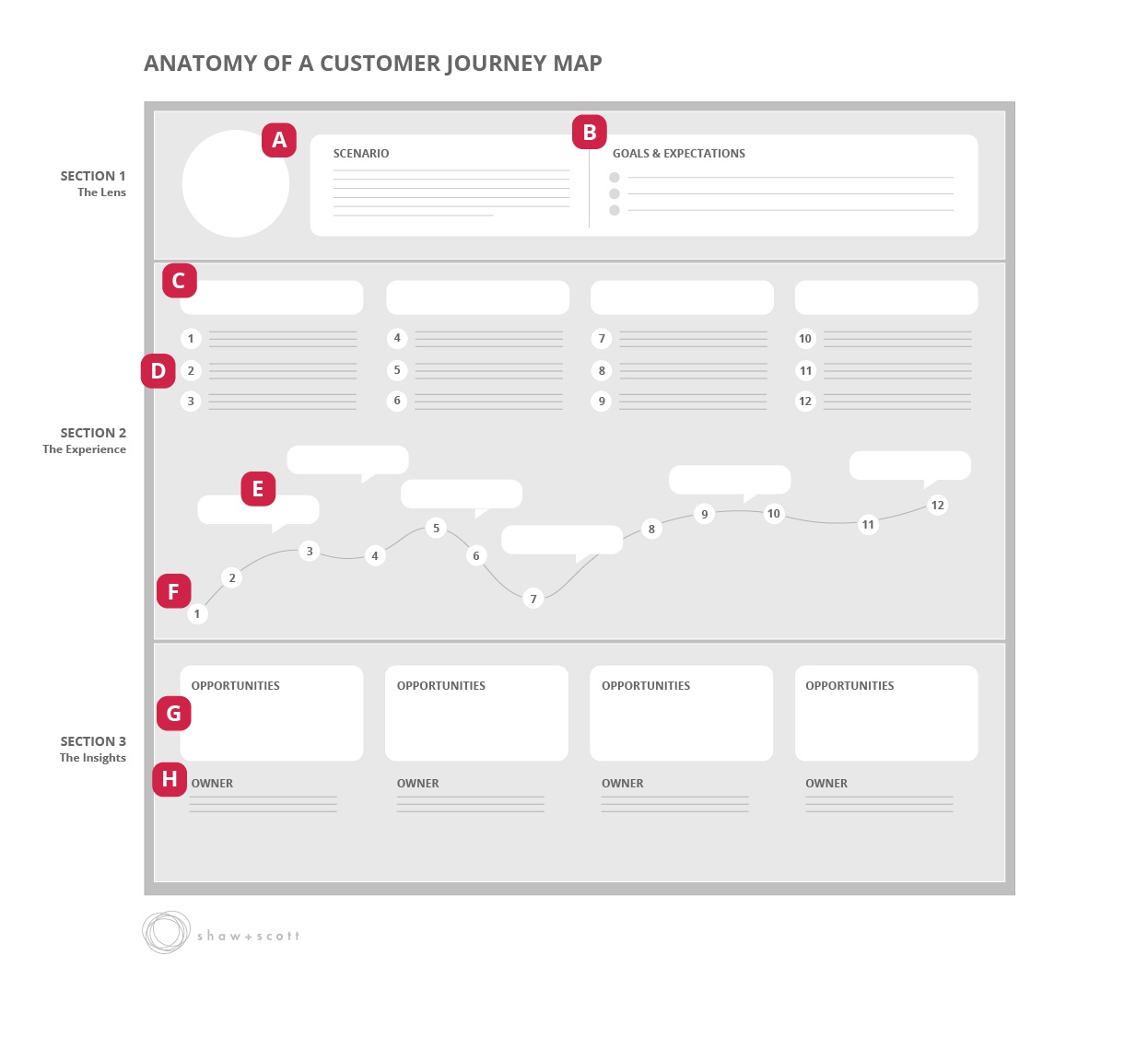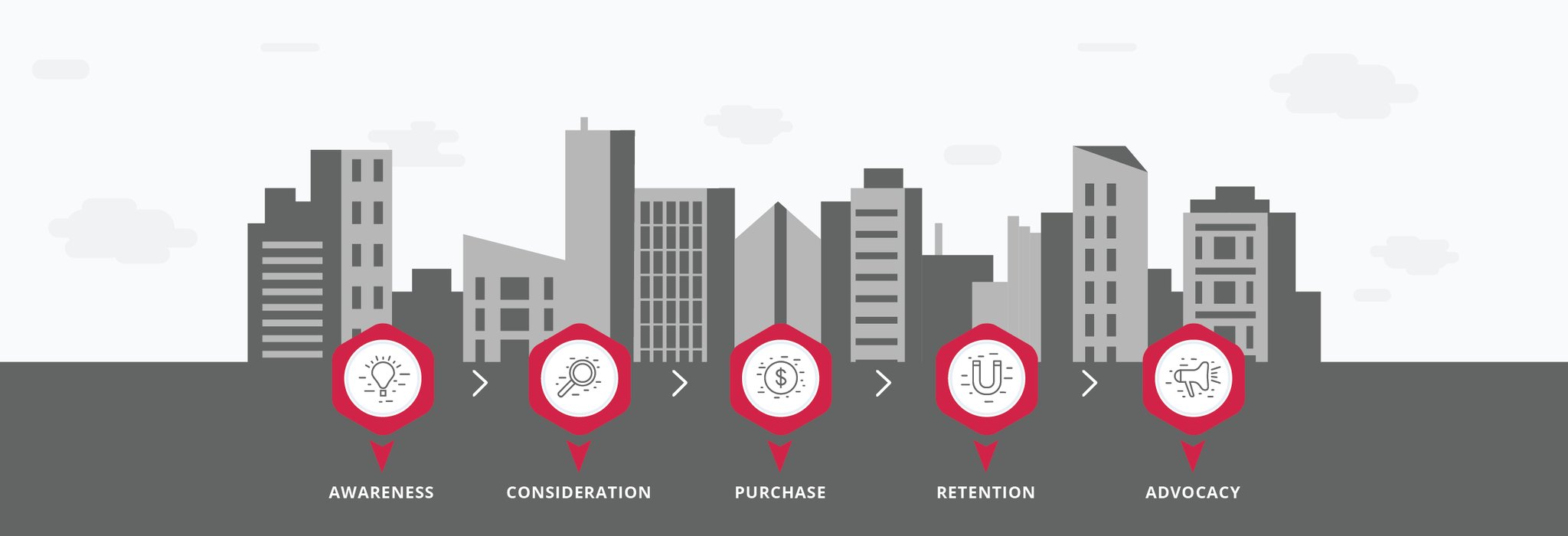Customer journey maps are a powerful way to gain insight into a customer’s experience and an essential component in a customer-centric marketing strategy. Mapping experiences can be complex, but beginning the process doesn’t have to be daunting, it’s simply a matter of following key guidelines and then customizing as needed.
At its most basic level, a customer journey map is a visualization of the process a customer goes through to accomplish a goal such as making a purchase or arranging travel. A well-crafted customer journey map gives stakeholders a deep, shared understanding of a dense landscape filled with quantitative and qualitative data, touchpoints and channels in a simple and accessible way. When done well, a customer journey map surfaces clear opportunities to improve the customer experience. It also provides a platform from which to assign ownership of the actions needed to implement new solutions and reap the rewards of new insights.
The foundation of the process
- Establish point of view. First, we must be able to answer two questions: what business goals have brought us to the exploration, and for whom is the experience most worth optimizing. It is this customer’s viewpoint that will become the lens through which the team will examine the events and actions as well as the feelings and thoughts our customers have as they move along the path. This is our hero, and it is their journey we care about most. With that said, an exploration may have several heroes, for example you might have multiple buyer personas, but you can likely only gain deep insight into one persona’s journey at a time. When creating a basic journey, use one map per view to arrive at a concise and insightful story. It may take some preparation to identify the most valuable customer profiles or create personas but clearly identifying who’s desires and pain points you are addressing will help in prioritizing actions later in the exercise. The goal is to set up the team to tell a concise story from which they will act.
- Chose the scenario. Journey maps are most useful when describing a sequence of events and the context that surrounds them. You can draw your scenario from an existing journey or explore a new journey. The scope of the journey is dependent on the reach of the business goal and therefore may be tightly focused to zoom into one stage of the buyer’s process, like the awareness or consideration phase, or zoomed out to encompass the whole process – such as following a customer from the time they spend researching vacation destinations through the post-vacation afterglow.
- Compile your hero’s thoughts, feelings and actions. The story will be driven by the actions, mindsets and emotions that your hero experiences throughout their journey. This is where your qualitative research comes into play and where the picture of the experience begins to take shape. For the journey to be authentic, you must use input that comes directly from the customer. Typically, this information comes from contextual inquiry, interviews, or some form of field study. It can also come from customer feedback via call centers or chatbots or other avenues in which customers give you a glimpse into their moods and motivations. Do not be tempted to rely on internal assumptions; pull data directly from the customers themselves
- Plot touchpoints and channels. The timeline of the journey aligns with the times at which your hero comes into contact with the brand. For example, when they are researching a product they intend to buy or booking accommodations for an upcoming trip. The channel is the place in which they interact directly with the brand – your website, mobile app, email, call center or physical location. This is often where the opportunities to improve the experience arise, because the gaps between the customer’s expectations and needs and the reality become evident.
- Prepare to take action. The purpose of the journey mapping process is to reveal where you may improve a customer’s experience and then set about making that happen. Any insights that arise during the mapping process must be documented and shared with the team. It is also critical to assign ownership over the opportunities. Without clear ownership over next steps the hard work and effort poured into the mapping experience will not result in a better experience for customers. If the project encompasses an omni-channel journey with multiple channel owners, it’s best to plan to address the political implications within the organization of making changes prior to the exercise. Setting ground rules going into the exercise will help the team focus their energy on the surfacing customer’s journey.
Now, let’s look at the elements of the canvas where we bring the map together.
The canvas
Some maps are focused on fine-tuning one touchpoint, such as a mobile app. Others encompass a complex, considered purchase that weaves the customer through digital and physical encounters with the brand over a series of months.
The scope of exploration – and the business goals prompting the map – will drive your map’s format, but there are common elements that most maps share:

Section 1: The lens provides a clear focus for the map by assigning (A) a persona (“who”) and (B) the scenario to be examined (“what”).
Section 2: The heart of the map is the visualized experience, usually aligned across (C) distinct phases of the journey. The (D) actions, (E) thoughts, and (F) emotional experience of the user throughout the journey can be supplemented with quotes or videos from research.
Section 3: The output should vary based on the business goal the map supports, but it could describe the insights and pain points discovered, and the (G) opportunities to focus on going forward, as well as (H) ownership.
Maps will take a wide variety of forms depending on context and business goals, but these basics will help your team begin a project with a solid foundation and unleash the power of visualization and storytelling in the service of providing stellar customer experiences.
If you would like help setting the foundation for your customer journey map or facilitating a mapping session don’t hesitate to reach Shaw + Scott at +1.520.762.4842 and press option 1, or reach out through our simple contact form.


